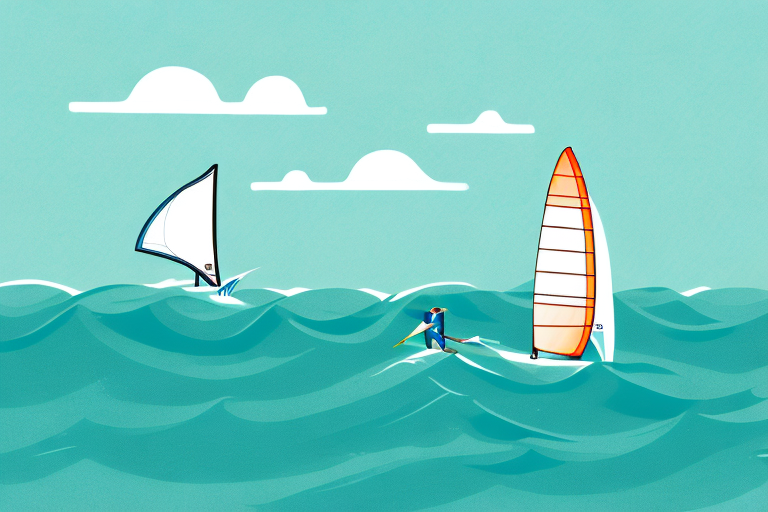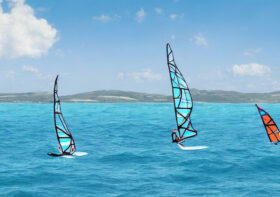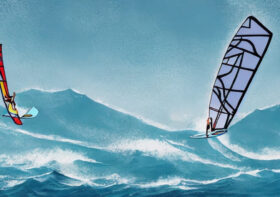Is Windsurfing Hard? – Tips To Make It Easy (2023)

If you’ve ever wondered if windsurfing is really as hard as it looks, the answer is: yes and no. Windsurfing can be an incredibly difficult sport to get the hang of, but with the right attitude and preparation, you can make it easier. In this article, we’ll discuss the different levels of windsurfing, and provide an overview of what you need to know before taking up the sport. We’ll also cover essential equipment, preparation and safety tips, and how to choose the right board for your skill level. Then, we’ll provide step-by-step instructions on learning the basics of windsurfing, the different techniques involved, and tips for improving your skills. Finally, to ensure you get the most out of your experience, we’ll discuss choosing the right conditions for windsurfing, troubleshooting common problems, advanced techniques for experienced sailors, common mistakes and how to avoid them, and tips for keeping motivated and having fun while you learn.
The Different Levels of Windsurfing
Windsurfing is a sport that can be enjoyed by people of all ages and skill levels. It has three distinct performance levels: beginner, intermediate, and advanced. Beginners typically learn on flat water, acquiring the necessary skills to progress to more advanced conditions. Intermediate windsurfers often enjoy bump-and-jump conditions, or learning to ride waves. Finally, advanced windsurfers usually specialize in wave sailing or racing.
What You Need To Know Before Taking Up Windsurfing
Before you take up windsurfing, there are some important things you need to know. First and foremost, you should understand that windsurfing is a physical activity that requires both strength and balance. You should also be comfortable with being in the water and be prepared to take on some risk. It’s important to familiarize yourself with basic sailing principles, such as tacking and jibing, before you go out on the water. Additionally, it’s important to be aware of potential weather and water conditions, as well as safety protocols. Finally, while it’s always a good idea to take lessons from a qualified instructor, you should also consider purchasing instructional videos and books before you hit the water.
Essential Equipment for Windsurfing
Before you head out on the water for your first windsurfing session, you’ll need to make sure that you have the right equipment. To get started, you’ll need a board (also referred to as a “sailboard”), a sail, and a boom. You may also want to invest in a harness (which helps keep your body in balance while sailing) as well as a wetsuit and protective gear (such as a helmet). Depending on your skill level, you may also want to consider purchasing additional equipment such as fins, footstraps and other accessories.
Windsurfing Preparation and Safety Tips
Before heading out on the water, it’s important to make sure that you are properly prepared and that your safety is your number one priority. Make sure that you check the weather conditions before you go out and have an idea of what kind of wind speed and direction you expect to encounter. Additionally, make sure that you understand the local regulations for windsurfing in your area. When on the water, always wear a personal flotation device (PFD) and pay close attention to any changing winds or waves. Make sure that someone on shore knows where you are going before setting off.
How to Choose the Right Board for Your Skill Level
Choosing the right board for your skill level can make all the difference when it comes to learning to windsurf. Beginners should look for boards that are wider, shorter, and have plenty of volume. Boards with more volume will provide better stability in light winds and choppy waters. As your skill level increases, you may want to look for boards that are longer and narrower with less volume. These boards are faster and more responsive in higher winds and more challenging conditions.
The Basics of Windsurfing – What You Need to Know
Before heading out on your first windsurfing session, it’s important to understand some of the basics of the sport. Windsurfers harness the power of the wind using a sail attached to their board. The sail pulls the board across the water in response to changes in wind direction. To steer the board, sailors use their feet to shift their weight on the board while turning the sail towards the desired direction. Additionally, sailors can use their hands on either side of the sail to adjust its angle depending on the direction they want to go.
Learning the Basics of Windsurfing – Step by Step Guide
Learning how to windsurf may seem intimidating at first, but don’t worry – with practice and patience it can be easy! The best way to get started is to find a qualified instructor who can provide expert guidance. Once you have an instructor’s guidance, start by mastering basic maneuvers such as tacking (turning into the wind) and jibing (turning away from the wind). As your skills progress, practice more advanced techniques such as water starting (getting up on your board from a floating position), sailing upwind, maneuvering in strong winds, and harnessing power from waves.
The Different Techniques Involved in Windsurfing
Windsurfing involves a variety of techniques that can help you improve your skills. Some of these techniques include tacking (turning into the wind), jibing (turning away from the wind), water starting (getting up on your board from a floating position), sailing upwind, maneuvering in strong winds, and harnessing power from waves. Additionally, experienced sailors may want to try more advanced techniques such as freestyle tricks or wave riding.
Tips for Improving Your Skills in Windsurfing
If you’re looking to improve your skills in windsurfing, it’s important to practice regularly in all kinds of conditions. Make sure that you practice basic maneuvers such as tacking and jibing until they become second nature. Additionally, don’t be afraid to try more advanced techniques – even if you don’t get it right away. As with any sport, practice makes perfect!
Choosing the Right Conditions for Windsurfing
When choosing which conditions are best for windsurfing, it’s important to consider both your skill level and the type of experience you want to have. Beginners should look for light winds (less than 15 knots) and flat waters so that they can focus on getting comfortable with sailing while keeping safety in mind. As your skills progress, you can challenge yourself by looking for stronger winds (over 15 knots) or choppy waters.
Troubleshooting Common Problems When Windsurfing
When learning how to windsurf or progressing your skills further, it’s inevitable that you’ll run into some common issues. If you find yourself struggling with technique or having trouble understanding something, don’t be afraid to ask questions or seek help from an instructor or more experienced sailor. Additionally, troubleshooting technical issues with your equipment can be difficult without help from an expert, so make sure that you have someone who can properly maintain your board.
Advanced Techniques for Experienced Sailors
Once you’ve mastered the basics of windsurfing and are comfortable sailing in different conditions, consider trying some more advanced techniques such as wave riding or freestyle tricks. These require more precise control of your board and sail which will take practice and patience! If you want to try something more extreme such as jumping or aerial maneuvers, always ensure that you have taken all necessary safety precautions.
Common Mistakes and How to Avoid Them When Windsurfing
No matter what skill level you’re at when it comes to windsurfing there are some common mistakes that everyone makes from time-to-time. One of the most common mistakes is not having enough power in your sail when getting up on the board. To avoid this mistake make sure that your sail is fully powered up before attempting any maneuver. Additionally, many sailors make the mistake of not adjusting their stance correctly when turning – make sure that you keep your feet shoulder-width apart when turning in order to maximize control.
Tips for Keeping Motivated and Having Fun While You Learn
Learning how to windsurf can be an incredibly rewarding experience – but it often takes time and patience! To stay motivated while learning make sure that you set achievable goals for yourself each time you go out on the water – this will help ensure that you stay focused on improving your skills while also having fun along the way. Additionally, don’t be afraid to try something new – even if it doesn’t work out perfectly! Part of learning how to windsurf is learning from mistakes – so use them as opportunities to get better!



Leave a Reply